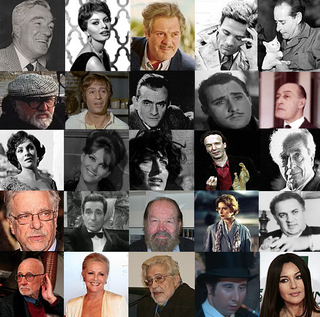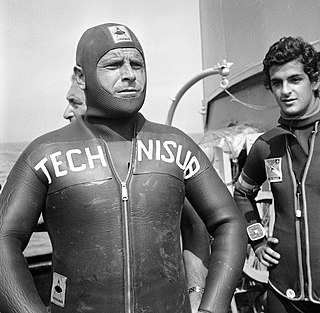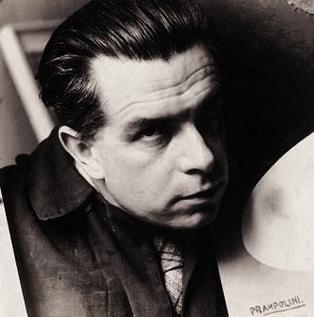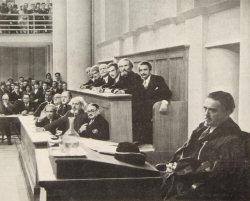
The cinema of Italy comprises the films made within Italy or by Italian directors. Italy is widely considered one of the birthplaces of art cinema, and the stylistic aspect of Italian film has been one of the most important factors in the history of Italian film. As of 2018, Italian films have won 14 Academy Awards for Best Foreign Language Film as well as 12 Palmes d'Or, one Academy Award for Best Picture and many Golden Lions and Golden Bears.

Grazia Maria Cosima Damiana Deledda was an Italian writer who received the Nobel Prize for Literature in 1926 "for her idealistically inspired writings which with plastic clarity picture the life on her native island [i.e. Sardinia] and with depth and sympathy deal with human problems in general". She was the first Italian woman to receive the prize, and only the second woman in general after Selma Lagerlöf was awarded hers in 1909.

Enzo Maiorca was an Italian free diver who held several world freediving records. Born Vincenzo Maiorca on 21 June 1931 in Syracuse, Sicily, he died on 13 November 2016 in the same city.

Eduardo De FilippoOMRI, also known simply as Eduardo, was an Italian actor, director, screenwriter and playwright, best known for his Neapolitan works Filumena Marturano and Napoli Milionaria. Considered one of the most important Italian artists of the 20th century, De Filippo was the author of many theatrical dramas staged and directed by himself first and later awarded and played outside Italy. For his artistic merits and contributions to Italian culture, he was named senatore a vita by the President of the Italian Republic Sandro Pertini.

Spaghetti alla puttanesca is a pasta dish invented in Naples in the mid-20th century and made typically with tomatoes, olives, capers, anchovies, garlic, peperoncino, extra virgin olive oil and salt.

Peppino De Filippo was an Italian actor.

Telefoni Bianchi films, also called deco films, were made by the Italian film industry in the 1930s and the 1940s in imitation of American comedies of the time in a sharp contrast to the other important style of the era, calligrafismo, which was highly artistic. The cinema of Telefoni Bianchi was born from the success of the Italian film comedy of the early 1930s; it was a lighter version, cleansed of any intellectualism or veiled social criticism.
Capo dei capi or capo di tutti i capi or Godfather are terms used mainly by the media, public, fiction writers and law enforcement community to indicate a supremely powerful crime boss in the Sicilian or American Mafia who holds great influence over the whole organization. The term was introduced to the U.S. public by the Kefauver Commission in 1950.

Augusto Genina was an Italian film pioneer. He was a movie producer and director.

Mario Camerini was an Italian film director and screenwriter.

Goffredo Alessandrini was an Italian scriptwriter and film director. He also acted, edited, and produced some films.

Bruno Corbucci was an Italian screenwriter and film director. He was the younger brother of Sergio Corbucci and wrote many of his films. He was born in Rome, where he also died.

Carmine Gallone was an early Italian film director, screenwriter, and film producer, who was also controversial for his works of pro-Fascist propaganda and historical revisionism. Considered one of Italian cinema's leading early directors, he directed over 120 films in his fifty-year career between 1913 and 1963.

Anton Giulio Bragaglia was a pioneer in Italian Futurist photography and Futurist cinema. A versatile and intellectual artist with wide interests, he wrote about film, theatre, and dance.

Carlo Ninchi was an Italian film actor. He appeared in more than 120 films between 1931 and 1963.

Enrico Prampolini was an Italian Futurist painter, sculptor and scenographer. He assisted in the design of the Exhibition of the Fascist Revolution and was active in Aeropainting.

Giovacchino Forzano was an Italian playwright, librettist, stage and film director. A resourceful writer, he authored numerous popular plays and produced opera librettos for most of the major Italian composers of the early twentieth century, including the librettos for Giacomo Puccini's Suor Angelica and Gianni Schicchi.

The Private Secretary is a 1931 Italian "white-telephones" musical film directed by Goffredo Alessandrini and starring Elsa Merlini, Nino Besozzi and Sergio Tofano. It was the Italian-language version of the German film Die Privatsekretärin.
The Charmer is a 1931 Italian comedy film directed by Guido Brignone and starring Armando Falconi, Tina Lattanzi and Ada Dondini. It is part of the White Telephone genre of films. It was shot at the Cines Studios in Rome.

Before the Jury is a 1931 Italian crime film directed by Guido Brignone and starring Marcella Albani, Lia Franca and Carlo Ninchi. It was made at the Cines Studios in Rome. The film is a precursor to the later genre of Giallo films.



















